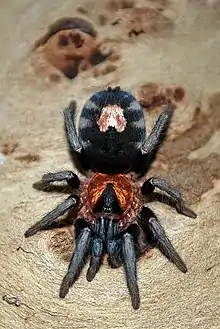| Cyriocosmus | |
|---|---|
 | |
| Cyriocosmus elegans | |
| Scientific classification | |
| Domain: | Eukaryota |
| Kingdom: | Animalia |
| Phylum: | Arthropoda |
| Subphylum: | Chelicerata |
| Class: | Arachnida |
| Order: | Araneae |
| Infraorder: | Mygalomorphae |
| Family: | Theraphosidae |
| Genus: | Cyriocosmus Simon, 1903[1] |
| Type species | |
| C. sellatus (Simon, 1889) | |
| Species | |
|
23, see text | |
| Synonyms[1] | |
| |
Cyriocosmus is a genus of tarantulas that was first described by Eugène Louis Simon in 1903.[4] They are small to medium spiders, with a bicolored or one same color carapace.[5]
Diagnosis
It differs from all other tarantulas by the paraembolic apophysis in the palpal bulbs of males, and a spermatheca with two spiral receptacles, which usually end in a caliciform or globular extension. Except for C. nogueiranetoi, which owns a S shape extension. All the species also own type 3 urticating hairs.[5]
Species
As of July 2022 it contains twenty-three species, found in South America, on Tobago, and Trinidad:[1]
- Cyriocosmus aueri Kaderka, 2016 – Peru
- Cyriocosmus bertae Pérez-Miles, 1998 – Brazil
- Cyriocosmus bicolor (Schiapelli & Gerschman, 1945) – Brazil[6]
- Cyriocosmus blenginii Pérez-Miles, 1998 – Bolivia
- Cyriocosmus elegans (Simon, 1889) – Venezuela, Trinidad and Tobago
- Cyriocosmus fasciatus (Mello-Leitão, 1930) – Brazil
- Cyriocosmus fernandoi Fukushima, Bertani & da Silva, 2005 – Brazil
- Cyriocosmus foliatus Kaderka, 2019 – Peru
- Cyriocosmus giganteus Kaderka, 2016 – Peru
- Cyriocosmus hoeferi Kaderka, 2016 – Brazil
- Cyriocosmus itayensis Kaderka, 2016 – Peru
- Cyriocosmus leetzi Vol, 1999 – Colombia, Venezuela
- Cyriocosmus nicholausgordoni Kaderka, 2016 – Venezuela
- Cyriocosmus nogueiranetoi Fukushima, Bertani & da Silva, 2005 – Brazil
- Cyriocosmus paredesi Kaderka, 2019 – Peru
- Cyriocosmus perezmilesi Kaderka, 2007 – Bolivia
- Cyriocosmus peruvianus Kaderka, 2016 – Peru
- Cyriocosmus pribiki Pérez-Miles & Weinmann, 2009 – Peru
- Cyriocosmus ritae Pérez-Miles, 1998 – Peru, Brazil
- Cyriocosmus sellatus (Simon, 1889) (type) – Peru, Brazil
- Cyriocosmus venezuelensis Kaderka, 2010 – Venezuela
- Cyriocosmus versicolor (Simon, 1897) – Paraguay, Argentina
- Cyriocosmus williamlamari Kaderka, 2016 – Venezuela
In synonymy
- C. chicoi Pérez-Miles, 1998 = Cyriocosmus bicolor
- C. planus (Fischel, 1927) = Cyriocosmus elegans
- C. rogerioi Pérez-Miles & Weinmann, 2009 = Cyriocosmus pribiki
- C. semifasciatus Mello-Leitão, 1939 = Cyriocosmus elegans
Transferred to other genera
- Cyriocosmus butantan Pérez-Miles, 1998 → Hapalopus butantan
- Cyriocosmus nigriventris Mello-Leitão, 1939 → Hapalopus nigriventris
See also
References
Wikimedia Commons has media related to Cyriocosmus.
- 1 2 3 Gloor, Daniel; Nentwig, Wolfgang; Blick, Theo; Kropf, Christian (2020). "Gen. Cyriocosmus Simon, 1903". World Spider Catalog Version 20.0. Natural History Museum Bern. doi:10.24436/2. Retrieved 2020-04-10.
- ↑ Raven, R. J. (1985). "The spider infraorder Mygalomorphae (Araneae): Cladistics and systematics". Bulletin of the American Museum of Natural History. 182: 152.
- ↑ Gerschman de P., B. S.; Schiapelli, R. D. (1973). "La subfamilia Ischnocolinae (Araneae: Theraphosidae)". Revista del Museo Argentino de Ciencias Naturales Bernardino Rivadavia. 4: 48.
- ↑ Simon, E (1903). Histoire naturelle des araignées. Paris: Roret. doi:10.5962/bhl.title.51973.
- 1 2 Kaderka, Radan (2019). "The genus Cyriocosmus Simon 1903 and two new species from Peru (Araneae: Theraphosidae: Theraphosinae)" (PDF). Scielo. Retrieved July 27, 2022.
- ↑ Gabriel, Ray (2017), "The revised taxonomical status of Cyclosternum bicolor (Schiapelli & Gerschman, 1945) (Araneae: Theraphosidae)", Journal of the British Tarantula Society, British Tarantula Society, vol. 32, no. 1, pp. 10–12, ISSN 0962-449X
This article is issued from Wikipedia. The text is licensed under Creative Commons - Attribution - Sharealike. Additional terms may apply for the media files.